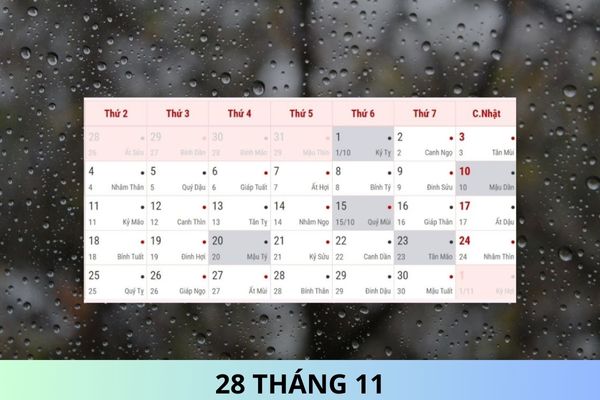What is the significance of November 28 in Vietnam? What is the lunar calendar date for November 28, 2024?
What is the significance of November 28 in Vietnam? What is the lunar calendar date for November 28, 2024?
On June 28, 1995, the Prime Minister of the Government of Vietnam issued Decision 380-TTg in 1995 stipulating that annually, starting from 1995, November 28 will be designated as "Vietnam Forestry Day."
The organization of "Vietnam Forestry Day" must achieve the following content and requirements:
- Educate the public on forest protection and environmental conservation; foster love for the profession, homeland, and country among forestry officials, workers, and employees.
- Encourage movements for competitive labor production and forest development with high productivity and quality; rational and economical use of forest resources.
- Mobilize and organize various sectors, associations, and communities to engage in concrete activities, projects, and beneficial deeds to report achievements to Uncle Ho; commend and reward good people, good deeds, localities, and exemplary units.
- The organization of "Vietnam Forestry Day" annually must be practical, effective, non-extravagant, and waste-free, ensuring the achievement of the said content and requirements.
Thus, November 28 is Vietnam Forestry Day. According to the lunar calendar, November 28, 2024, corresponds to October 28, 2024 (lunar calendar).

What is the significance of November 28 in Vietnam? What is the lunar calendar date for November 28, 2024? (Image from Internet)
What are the basic contents of the sustainable forest management plan in Vietnam?
According to Article 27 of the Forestry Law 2017, the sustainable forest management plan is stipulated as follows:
Article 27. Sustainable forest management plan
- The responsibility for developing and implementing a sustainable forest management plan is stipulated as follows:
a) Forest owners who are organizations must develop and implement a sustainable forest management plan;
b) Encourage forest owners who are households, individuals, community groups, or linked families and individuals to develop and implement a sustainable forest management plan.
- The basic contents of the sustainable forest management plan for special-use forests include:
a) Assessing natural, socio-economic conditions, national defense, security; forest ecosystem status, biodiversity, genetic resources, historical-cultural relics, landscapes;
b) Determining the objectives and scope of sustainable forest management;
c) Identifying the area of forest in functional subzones that is degraded, restored, and conserved;
d) Identifying activities for management, protection, conservation, development, and use of the forest;
dd) Solutions and organizational implementation.
[...]
The basic content of the sustainable forest management plan includes:
[1] The basic content of the sustainable forest management plan for special-use forests includes:
- Assessing natural, socio-economic conditions, national defense, security; forest ecosystem status, biodiversity, genetic resources, historical-cultural relics, landscapes
- Determining the objectives and scope of sustainable forest management
- Identifying the area of forest in functional subzones that is degraded and restored, and conserved
- Identifying activities for management, protection, conservation, development, and use of the forest
- Solutions and organizational implementation
[2] The basic content of the sustainable forest management plan for protective forests includes:
- Assessing natural, socio-economic conditions, national defense, security; forest resource status
- Determining the objectives and scope of sustainable forest management
- Determining the protective function of the forest
- Identifying activities for management, protection, development, and use of the forest
- Solutions and organizational implementation
[3] The basic content of the sustainable forest management plan for production forests includes:
- Assessing natural, socio-economic conditions; forest resource status; production, business results; market assessment impacting the forest owner's activities
- Determining the objectives and scope of sustainable forest management
- Identifying activities for management, protection, development, use of the forest, and forestry trade
- Solutions and organizational implementation
Under what circumstances does the state reclaim forest land in Vietnam?
According to Article 22 of the Forestry Law 2017, the state reclaims forest land under the following circumstances:
- Forest owners use the forest contrary to its purposes, deliberately do not fulfill obligations with the State, or seriously violate forestry laws
- Forest owners do not carry out activities for forest protection and development for 12 consecutive months from the date of forest allocation or lease, unless there is a force majeure event confirmed by competent state authority
- The forest owner voluntarily returns the forest
- The forest allocated or leased by the state expires without renewal
- Forests are allocated or leased without proper authorization or to incorrect entities
- The forest owner, being an individual, dies with no legal heir
- Other cases of forest land reclamation as regulated by the Land Law










